John Watson Book Reviews (#97)
History and General Works Part 2. John Watson Book Review #97
IM John Watson - Saturday 8th January 2011

Winning Chess Middlegames by Ivan Sokolov. | http://www.ukgamesshop.com/
John Watson returns with a series of book reviews on Historical matters as well as some works from various categories. Books covered: How Chess Games are Won and Lost by Lars Bo Hansen. Improve Your Chess by Learning from the Champions by Lars Bo Hansen. Chess Duels: My Games with the World Champions by Yasser Seirawan; Winning Chess Middlegames: An Essential Guide to Pawn Structures by Ivan Sokolov. Chess Secrets: Heroes of Classical Chess; Learn from Carlsen, Anand, Fischer, Smyslow and Rubinstein by Craig Pritchett; Bullet Chess: One Minute to Mate by Hikaru Nakamura and Bruce Harper. HHdbIV (Endgame Study Database DVD, 4th edition) by Harold von der Heijden. Bobby Fischer, the Career and Complete Games of the American World Chess Champion by Karsten Müller.
Over the summer and fall I must have collected notes and impressions on several dozen books, but there always seem to be higher priorities than writing reviews. I have recently had the good fortune to be immobilized by a rib injury, giving me the excuse to catch up on my serious chess reading! This and the next few columns are the result of this mishap. As I discovered, chess authors and presenters (on DVDs) have been supplying the world with many fine and enjoyable works.
In the distant days of my last columns, I talked about some works dealing with chess history and left the reader expecting more on that subject. Well, in the meantime we've seen a dramatic increase in books in that genre. Likewise, there has been a raft of general works over the last two years, for example, games collections and middlegame books. I can't possibly address all of these in detail, obviously, but I'd like to cover some ground before reverting to other more specialised works. The nice thing about history and strategy books is that they don't lose their relevance with time, or at least shouldn't.
Over the past 3+ years, I've had about 170 guests on my 'Chess Talk with John Watson' internet radio shows on ChessFM. Naturally I've read the works of my guests more thoroughly than most, not the least because I choose to invite authors whose works I admire and enjoy. So let me use the present column to examine a selection of those:
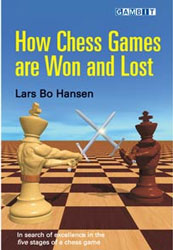
How Chess Games are Won and Lost; Lars Bo Hansen; 255 pages; Gambit 2008
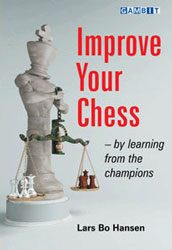
Improve Your Chess by Learning from the Champions; Lars Bo Hansen; 191 pages; Gambit 2009
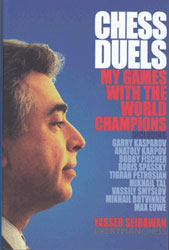
Chess Duels: My Games with the World Champions; Yasser Seirawan; 427 pages; Everyman Chess 2010
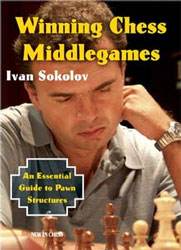
Winning Chess Middlegames: An Essential Guide to Pawn Structures, Ivan Sokolov; 286 pages; New in Chess 2009
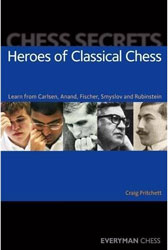
Chess Secrets: Heroes of Classical Chess; Learn from Carlsen, Anand, Fischer, Smyslow and Rubinstein; Craig Pritchett; 224 pages; Everyman 2010

Bullet Chess: One Minute to Mate; Hikaru Nakamura and Bruce Harper; 248 pages; Russell Enterprises 2009

HHdbIV (Endgame Study Database DVD, 4th edition); Harold von der Heijden 2010
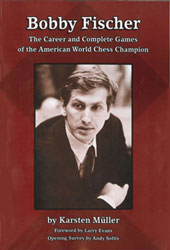
Bobby Fischer, the Career and Complete Games of the American World Chess Champion; Karsten Müller, 408pages; Russell 2009
Looking over the books of Lars Bo Hansen recently, I realized they were some of my very favorites from the past five years or more. They are extremely instructive, with original ideas and great game examples, and Hansen's explanations are easy to follow. What else do you need in a book?

Let me concentrate upon Hansen's two books from 2008 and 2009: How Chess Games are Won and Lost (subtitled "Examining the five Stages of a Chess Game", published in 2008), and Improve Your Chess by Learning from the Champions, published in 2009. Both expand upon Hansen's Foundations of Chess Strategy (previously reviewed in this column) but deal with fundamentally new topics. In How Chess Games are Won and Lost, Hansen splits a chess game into five phases, with a lengthy chapter devoted to each: The Opening; Transition from Opening to Middlegame; The Middlegame; Transition from Middlegame to Endgame; and the Endgame. In particular, his endgame chapter discusses what he calls 'technical endgames', to distinguish them from the general endgame issues which we see in the transition stage. Once you think about it, this is an obvious and next step in our description of chess; the traditional division into opening, middlegame, and endgame is awkward, and more artificial than it needs to be. Readers and students, for example, have often complained about the lack of guidance in the transition stages. Dividing things into five stages is obvious enough, but who has put it down on paper in this form?
Every section includes both a description of key elements and advice for the student. In the openings section, he first deals with traditional elements such as controlling the centre, developing (with minor pieces first), king safety, connecting rooks, etc.; and in general, preventing or obstructing the opponent from achieving these things himself. He also has a section called "The Modern Trend: Breaking the Principles", with topics such as the virtues of an offside knight, pawn sacrifices for initiative, foregoing castling, allowing doubled pawns, and starting flank attacks early on (with an emphasis on g4 attacks). These are topics I have looked at in my books Secrets of Modern Chess Strategy and more so in Chess Strategy in Action, and I think it's fair to say that he agrees with my assessment that modern players are increasingly likely to think in pragmatic terms, i.e., the best move is 'whatever works', with less attention given to broad philosophic ideas. Like many others, he attributes this trend at least in part to computer engines. The openings chapter ends with a lengthy description of how to match openings to your style and strength, with terrific examples of why these considerations are as important as topicality or precise theoretical assessment.
The chapter on transition from opening to endgame concentrates upon 'strategic' factors, i.e., long-term features such as pawn structure and decisions about where to launch an attack. Hansen thinks, correctly, that this is a 'vastly underestimated' area. In a fairly traditional exposition, he describes types of pawn centres, emphasizing the question of where to attack. Again, the chapter concludes with advice about adapting ones personal style to the opening-middlegame transitions, harking back to the player types that he first defined in Foundations of Chess Strategy.
The middlegame chapter includes topics like the nature of an advantage (and transformation of advantages), the art of defence, attacking rules and methods, tactics, and manoeuvring. Hansen then turns to the transition from middlegame to endgame, with all kinds of practical and instructive examples. I was amused to see him address the famous endgame adage 'Do not hurry', pointing out simply that it applies in some cases and doesn't in others. In my experience as a teacher, I find that I have to emphasize the importance of each tempo (and 'hurrying', I suppose) in the majority of endgames, in spite of the many classic examples we see in the textbooks in which correct play involves patient 'tacking' and avoiding premature breakthroughs. Finally, How Chess Games are Won and Lost offers practical tips, for example, techniques of time management, using computers, and preparation for opponents.

Hansen's more recent book, Improve Your Chess by Learning from the Champions, is first and foremost an overview of chess history in terms of the evolution of chess thought and chess styles. But it is informed throughout the same subjects and insights as appear in Hansen's earlier books. Chess history is split up as follows: The Romantic Era; The Scientific Era; The Hypermodern Era; New Dynamism; The Age of Universality; Creative Concreteness; and Chess in the Future. The players in each era are pretty much as have been traditionally assigned, for example, Philidor, Anderssen, and Morphy in the romantic era, but in each chapter, Hansen shows many examples of modern play in that style, for example, Kasparov playing 'romantic' games. Steinitz's scientific style reappears in games by Capablanca, Kramnik, Carlsen, and Anand, with numerous games by the author himself. The Hypermodern Era concentrates upon Nimzowitsch and his modern 'student' Larsen, with many examples by the like of Karpov and Petrosian. And so forth. The chapter 'Creative Concreteness' reveals Hansen's view of the modern tendencies, and he includes games between a wide variety of contemporary players. Finally, he has a chapter called 'Chess in the Future: The Era of Transformation. It describes what qualities future players will need, among them having a breadth of openings, using strategic rather than tactical openings, taking calculated risks, and having a great deal of energy and stamina. He thinks that the distinction between Black and White will decrease, while psychology and adapting ones game according to ones opponent will play an increasing role.
These are well-written, clear, and user-friendly books which speak to the reader throughout. They are whole-heartedly recommended.

Yasser Seirawan's Chess Duels: My Games with the World Champions is a narrative of Seirawan's experiences on and off the board. The bulk of the book consists of a collection of all of Seirawan's games against a variety of world champions spanning from Smyslov through Kasparov. (It stops before Anand and Kramnik, perhaps because he played them rarely, and possibly also for reasons of space). Seirawan not only annotates these complex games in fine style, but tells funny and interesting stories about the players. The notes are also full of descriptions of his own thoughts and emotions during the games. Seirawan's annotating style has always had many admirers (his old Inside Chess columns are reproduced at ChessCafe.com), and you will see why as you travel through this book.
The first part is autobiographical, describing Seirawan's many homes and travels as a child and young man. He turns to chess with a 28-page essay entitled 'Bobby Fischer'. Seirawan didn't play Fischer over the board, but they met upon occasion and he has several new stories about him, including a lengthy account related to him by a German industrialist who wanted Fischer to play a single game for his team. You'll have to read the book to see what happened. At first Seirawan got along well with Fischer, although like everyone, he eventually incurred Fischer's wrath (in this case by writing a book about the 1992 Spassky match). Much of this chapter is actually devoted to Viktor Korchnoi, for whom Seirawan served as a second.
Seirawan has entertaining descriptions of each champion, often derived from personal experience. As for the games themselves, as he says, "The bulk of this work focuses upon three players: Boris Spassky, Anatoly Karpov and Garry Kasparov, the three giants I played most often." Still, I found the chapters against the old champions very interesting. Seirawan had an even score against Smyslov and he absolutely devastated Tal 4.5-0.5. To be fair, that result came when Tal was past his prime, but is still indicative. With Spassky, Seirawan has more trouble: 3.5-6.5, but was doing quite well in most of the games and held his own in terms of strategic insight. The lengthy Karpov chapters are wonderful, both from a chess and anecdotal point of view, because we read so little about Karpov in chess literature outside of his games. Seirawan hosts Karpov and the two spend time around Seattle; the ex-World Champion comes off well in his eyes. In the end, Seirawan does more than respectably against Karpov, with a 5.5-7.5 score in Classical chess and an even Rapids score. Finally, Kasparov comes out 4-2 against Seirawan. Not bad at all for the latter, and these games come from Kasparov at his prime, where he had better scores than that against most of the world's elite. Incidentally, the longest annotated game in the book is Kasparov-Seirawan, Barcelona 1989, which covers 20 pages!
Chess Duels: My Games with the World Champions is a highly enjoyable, readable book with excellent games and notes. I can't do justice to its multitude of absorbing and amusing anecdotes, but it is on every Book-of-the-Year short list, which says it all.

Ivan Sokolov is one of the few active and successful veteran grandmasters to have written a serious book on middlegame strategy, and it's a very good one. His Winning Chess Middlegames: An Essential Guide to Pawn Structures is a study of four categories of standard pawn structures: doubled pawns, isolated pawns, hanging pawns, and central pawn majorities. The material is specialised, arising almost exclusively from d-pawn openings, mostly Nimzo-Indians and double d-pawn openings. In the first chapter on doubled pawns, for example, he looks at 12 structures, each represented by a game or sometimes more than one game, with detailed and copious notes. The first 11 structures, represented by 18 games, all arise from the Nimzo-Indian Defence, and deal with White's doubled c-pawns arising after …Bxc3. The 12th structure is represented by a single English opening game (Kasparov-Ivanchuk) in which Black plays …Bb4 and …Bxc3, also creating doubled c-pawns. The chapter on isolated pawns is limited to isolated d-pawns in d-pawn openings (and the hanging pawns created from them). The chapters "Parallel Hanging Pawns in the Centre" (called simply "Hanging Pawns" in the Contents, but correctly renamed in the body of the book) has to do exclusively with pawns on c5 and d5, again arising from openings with 1 d4. Finally, "Pawn Majority in the Centre" has seven "essential structures" from d-pawn openings.
This brings the title into question, since it implies a broader look at pawn structures of all kinds, and the reader isn't forewarned that nothing of the sort appears. In my experience, the publisher chooses a title more-or-less independently of the author, so I'll give Sokolov a pass, and the New in Chess crowd a mild (and unproven) reprimand. Alexander Baburin's extremely popular and well-written book Winning Pawn Structures is even guiltier on this account, dealing only with isolated queen pawns and its descendants!
At any rate, once you accept the boundaries on the subject matter, the book shines. Sokolov, with a straightforward writing style and evident pleasure in his material, pours his knowledge and experience into each game. He continually points out to the reader positional themes and tactical devices, saying, e.g., "This is useful for the reader to remember", "a typical plan worth remembering", "...useful for the reader to take note of - it can also occur in similar positions", "a typical reaction which it is worth remembering, since it mostly works in these positions", etc. The text is sprinkled with "Note that" and "the standard…". To my mind, this is precisely the way to learn middlegames (and openings, for that matter). If you don't learn a great number of standard formations and the slight differences between them, none of the endless advice in books about 'how to look at chess positions' will help you. There is no shortcut to a close understanding of structures in conjunction with the themes and tactics that accompany them. Sokolov clearly recognizes this. If you want to know about the particular structures (and openings) that he talks about, then you can't do better than to read this book.
Winning Chess Middlegames also provides a reasonable technical introduction to each of the opening variations in the 45 games, which encompass numerous lines of the Nimzo-Indian, Tarrasch Defence, Queen’s Gambit Declined Tartakower Defence, Semi-Tarrasch and Queen’s Indian Defence. That's because he includes many concrete alternatives to various opening moves, often giving a complete or near-complete game with excellent notes. Like any good player, he pauses for moves that are either positionally or tactically beautiful, which helps keep the book from becoming too technical. There are some wonderful moves, sometimes not relevant to the main themes, which make this book an excellent game collection as well as an educational treatise. Sometimes I think Sokolov goes a bit overboard, e.g., when he devotes 11 pages to the already over-analysed Fischer-Spassky, game 6, Reykjavik 1972. But even there he gives a clear exposition of thematic ideas, adds much new analysis, and makes a few provocative remarks on the side, for example, after Spassky's 20…d4?: "An inexplicable mistake for a player of Spassky's calibre. Did he really fear Fischer so much?".
I can heartily recommend Winning Chess Middlegames, with the understanding that it deals with a fairly narrow range of middlegames arising from a limited set of openings. The middlegames are extremely important ones, however, and should be understood by every chessplayer who proposes to know the game as a whole. In the end, the combination of terrific instructional content and great games makes this a worthwhile purchase for experienced players from club level up to master, and even above that.
Everyman is always coming up with new series of books, and over 2009-10 a set of four 'Chess Secrets' books appeared, featuring the play of various great players whose styles of play resemble each other and reflect a similar overall approach to the game. Neil McDonald wrote two books in this series: Chess Secrets: The Giants of Strategy: Learn from Kramnik, Karpov, Petrosian, Capablanca and Nimzowitsch; and Chess Secrets: The Giants of Power Play, which is about Morphy, Alekhine, Bronstein, Geller, and Topalov. I haven't had the chance to read these, but McDonald is consistently one of the best and most accessible writers around, and just about everything he writes contains an element of instruction that makes reading him worthwhile. Colin Crouch, another excellent writer, authored Chess Secrets: Great Attackers: Learn from Kasparov, Tal and Stein. However, the only book that I read in depth from this series is Craig Pritchett's Chess Secrets: Heroes of Classical Chess; Learn from Carlsen, Anand, Fischer, Smyslow and Rubinstein.

In it, he examines five players whose style exemplifies "classically direct, clear, energetic, tough, ambitious, yet fundamentally correct, chess playing attributes." That's quite a handful of attributes! And yet there's certainly a connection, certainly in terms of correctness. Pritchett told me that "Above all, I set the players, their games and achievements in a historical context". With that in mind, I checked their birthdates: Rubinstein 1881; Smyslov 1921; Fischer 1943; Anand: 1969; Carlsen: 1990. Roughly 20 year gaps, with 40 between Rubinstein and Smyslov. Let me see: Max Euwe was born in 1901, and he shares all of these qualities (excepting perhaps 'energetic'); I nominate him for the next edition.
In his Introduction, Pritchett says of the heroes: "They see chess primarily as an organic whole, not as a series of artificial phases. They don't attack or defend for the sake of it, but only when the position demands it. They are equally at home whether playing the opening, middlegame or endgame." Of course, attributing styles to players is always dicey, especially modern players, who are more or less compelled to be 'universal'. Anand is particularly flexible, to my mind, and sometimes revels in murky complications; nevertheless, I think that 'direct', 'energetic', and 'clear' indeed generally apply to his play. Carlsen of course hasn't finished developing, and I wouldn't say that he is always 'direct'; at least I don't always understand what he's up to! Well, that's the fun of this sort of discussion; the nice thing is that in spite of the game's advances, players still have distinct styles to match against one another.
Pritchett includes a biographical element to each section, following the basic outlines of each player' career. He annotates seven games for each player, and his notes are not only the most important but the best part of the book. They are highly readable, with more prose and reflection than heavy analysis. When Pritchett does go into analytic mode, he is correctly critical, citing mistakes, and yet he doesn't spoil the drama of the game, as too many notes can easily do. I think most readers will enjoy this book; it has a nice pace and an excellent selection of games.

Moving to a unique realm, I want to briefly mention Bullet Chess: One Minute to Mate, by Hikaru Nakamura and Bruce Harper. Nakamura is an extraordinarily exciting player who is keeping me exceptionally interested in international chess, and has been a terrific guest. He is not only in the world's elite (having just climbed to #10 in live rating), but he is also famous for his play on ICC, where he has held the rating records for all time controls, and in particular Bullet chess. Hikaru dominated ICC Bullet chess for many years, so much so that at one point he achieved a rating more than 200 points above his nearest competitor. Bruce Harper is an experienced writer about chess and expert game designer. In particular, he and co-author Yasser Seirawan wrote Chess on the Edge: The Collected Games of Canadian Grandmaster Duncan Suttles, which I reviewed in this column. I won't go into detail, but I'm pretty sure that Bullet Chess: One Minute to Mate is the only book out there about the fun, techniques, and tricks associated with Bullet chess. It naturally draws upon examples from ICC, and we find chapters on such topics as 'Pre-moving', 'Winning in the Opening', 'Bullet Endings', 'Common Mistakes', 'Psych Outs', 'Falling Apart', and 'Knowing When to Stop'. There are also tips, for example, you should consider simplifying to even a lost endgame, because in practice, many endgames take longer to win than middlegames!

I feel obliged to mention Harold von der Heijden's HHdbIV Endgame Study Database, but very briefly, because this is not a column about endgame books or DVDs. I do find this product remarkable, however, and want to give it a short plug. This is the 4th edition of his database collection of endgame studies. It is by far the largest such collection in the world, with 76,132 studies. The studies include variations, cooks, input from Endgame Tablebases, and much more information, for example, cases of plagiarism, studies that were inspired on a previous study, and so forth. All the information about the database, and how to order and download it, can be found at www.hhdbI.nl .
One last guest on my show, Karsten Müller, has been exceptionally productive over the past two years. Müller is particularly well-known for his ending Fundamental Chess Endings (co-authored with Frank Lamprecht) and his extensive writing about the endgame, for example, in his columns on ChessCafe and Chessbase, as well as his book How to Play Chess Endgames, co-authored with Wolfgang Pajeken. A few years ago, he put out a 4-DVD lecture series on endgames for ChessBase, and just this year, Müller put out three more endgame DVDs in the same series, called Chess Endgames 5 through 7, dealing with practical endgame problems. These are works which don't fit in with this column, and some will be discussed in later ones (e.g., about endgames).

But at the end of last year, Müller came out with a real labour of love, Bobby Fischer, the Career and Complete Games of the American World Chess Champion. It is primarily an annotated games collection, containing 736 tournament and match games by Fischer from 1955 and 1992, all annotated by Müller, some in detail and some lightly. A brave undertaking, to be sure, and the author is up to it. The book also has crosstables, tournament results, some photographs, and limited biographical material (mostly tracking his achievements). Larry Evans writes the Foreword, while Andy Soltis contributes a survey of Fischer’s openings. As Mueller said on my show, he sticks with facts and Fischer's games, avoiding gossip, rumours, speculation about Fischer's psychology, and aspects of his personal life, and prejudices. Therefore Fischer fanatics who only crave more details or arguments about his anti-Semitism, religious beliefs, or whatever won't find what they want here. This is a book for those who want to study and enjoy Fischer's games. There is nothing else like it out there.


 TWIC is 30. First issue 17th September 1994.
TWIC is 30. First issue 17th September 1994.




